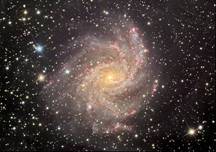
For the next few weeks we will be focusing on the northern sky and the stars that are up most of the year. This is a great time to find the Big Dipper. The seven unmistakable stars hang high in the northwest after sunset (upside-down). If you locate a dipper which one is it? Big or Little? If you live in or near a city - no need to fear. You can only see the Big Dipper. Four of the seven stars of the Little Dipper are too faint to see in a light polluted sky.
Different cultures imagined quite different pictures in these stars. In medieval Europe it was a death cart or wagon. Some Native American groups called it the "Thigh of an Ox" while others used it as a eye test (see if you can see an extra star hovering just above one of the seven). Egyptians called it a coffin. African Americans called it the "Drinking Gourd". In England they still call it The Plow.
Here is a very famous painting by Vincent van Gogh called "Starry Night over the Rhone". It's pretty obvious where the Big Dipper is. Van Gogh included stars in several of his paintings including Starry Night and Cafe Terrace at Night.
-

-

If you have trouble seeing any of those things in the Big Dipper, try to modernize it. Maybe to you it will look like a lawn mower, shopping cart, or question mark. Don't ask me why that shopping cart is in a jacuzzi...
-













